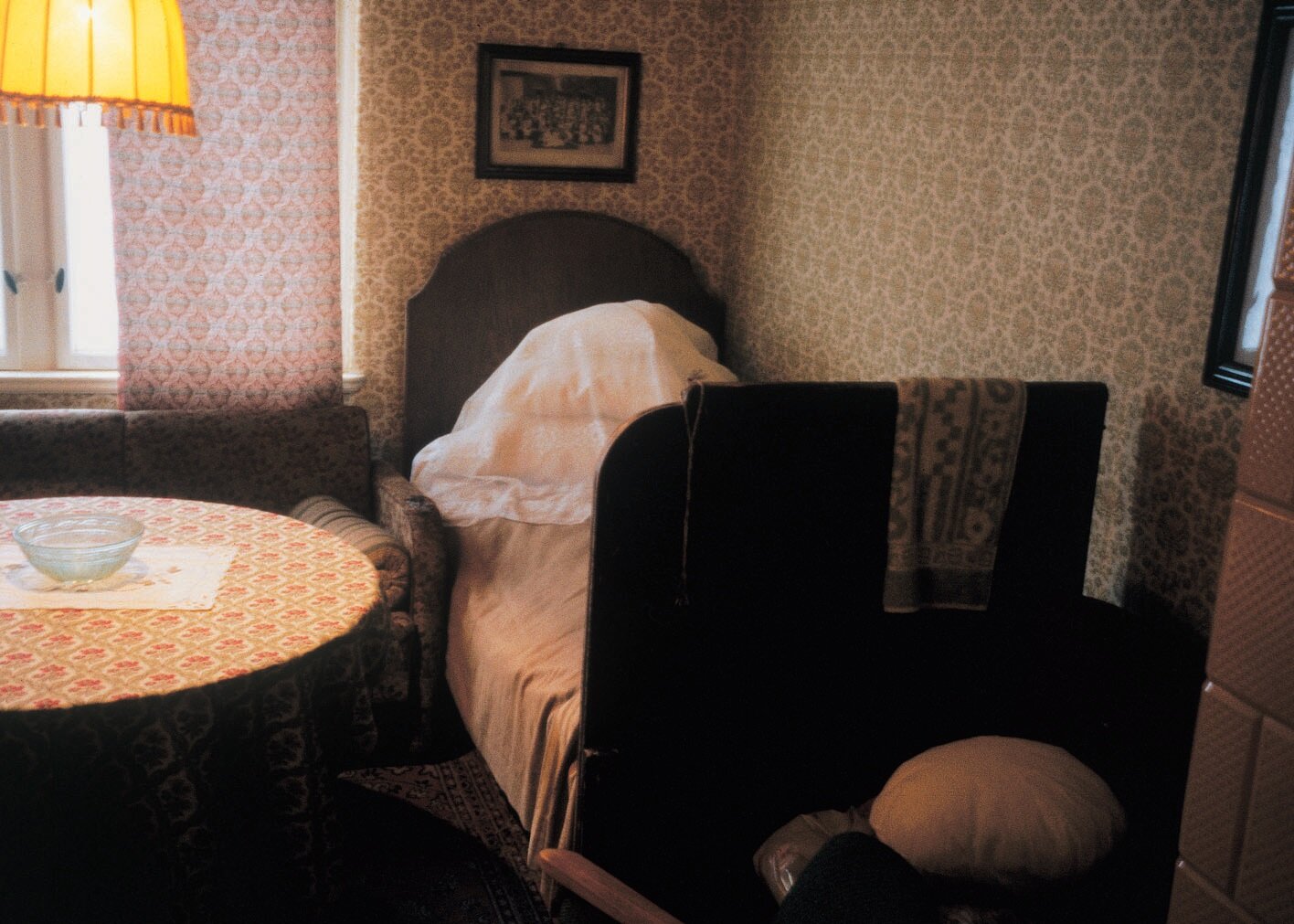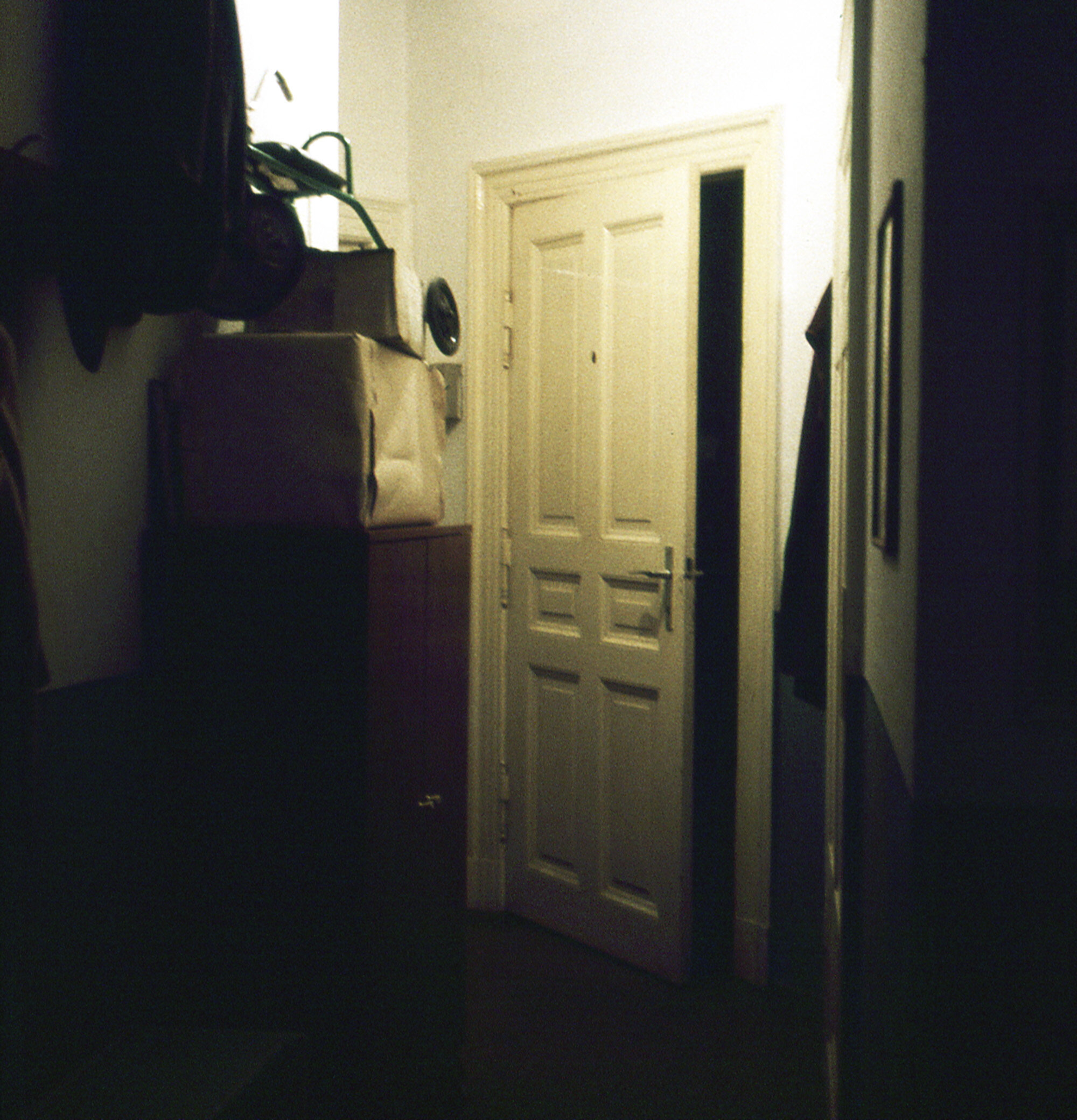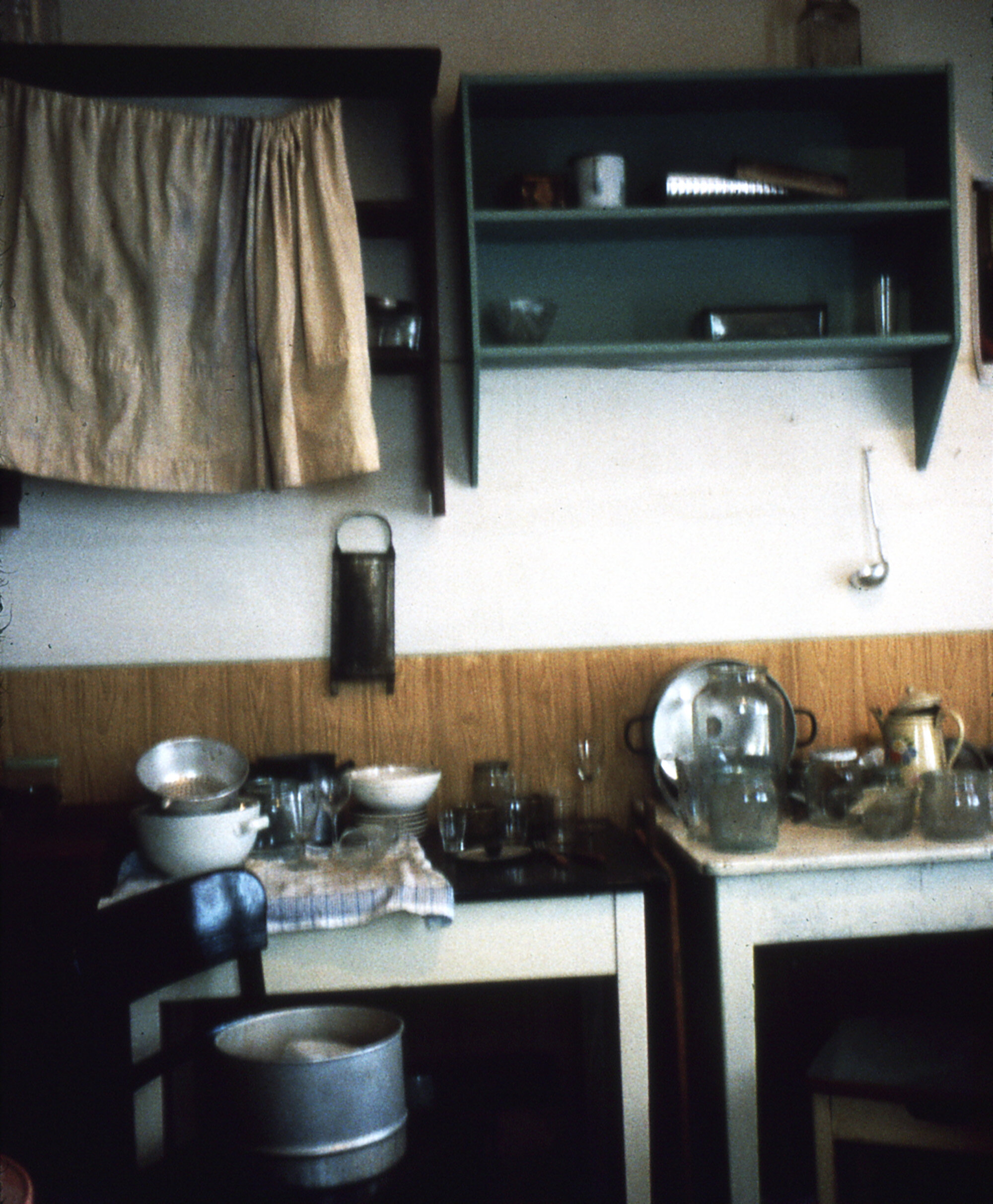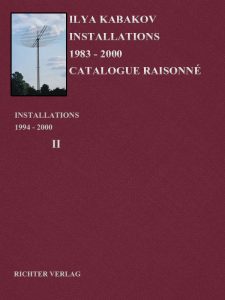Voices Behind the Door
YEAR: 1996
CATALOG NUMBER: 105
PROVENANCE
Not preserved
EXHIBITIONS
Galerie für Zeitgenössi – sche Kunst Leipzig, Germany
Stimmen hinter der Tür, 23 Nov 1996 — 22 Dec 1996
CONCEPT AND DESCRIPTION OF THE INSTALLATION
In November of 1996, we built an entirely realistic ‘communal apartment’ on the second floor of a small estate amidst old trees that in turn stood near an old, large villa where the Gallery of Modern Art of the city of Lipsia is located. In order to understand the nature of the installation and why it was built in such an unexpected place, we first must describe this estate.
It, as we have said, was a two-story structure where previously, i.e., 60 years ago, there was an apartment on the top floor for the manager of the nearby villa. There are three rooms in it off of a narrow corridor, and a small kitchen. When we entered, everything was empty, abandoned, and it seemed that no one had resided in the apartment for a long time. But the walls, floor, and ceiling, though cracked and very shabby, were nonetheless still quite strong, and the appearance of a former residence was preserved. Down below on the first floor, there were two other spaces: a large space for a carriage and a stable with stalls for three horses.
In such a situation the installation Communal Apartment just begged to be built. Moreover, it was clear that we could use for this purpose only the second floor and staircase leading to it. We did this entire reconstruction that was intended to transform a long-abandoned manager’s house into an over-crowded Moscow ‘communal apartment’ together with students from the Institute of Art History of the Art Academy in Lipsia. The entire work, from start to finish, turned out to be one unified learning process.
There were two component parts in the installation, in its very concept: the construction of the very interior of a Soviet communal apartment with all of the things usually filling it up – furniture, clothing, lamps, dishes, and other domestic clutter – and the voices of people resounding in such a place, the residents, inhabitants of this communal apartment.
First a few words about these ‘voices.’ As everyone knows, each room in a communal apartment belonged to one family, and so in our apartment, there were three families and one shared communal kitchen. When the viewer entered the apartment, this kitchen was immediate to his right in the first room, and from it emanated very loud voices, interrupting one another, of two women and one man, who were heatedly shouting out separate phrases that, if you listen closely to them, represent incessant cursing, accusations against one another about the most unthinkable actions and transgressions that each opponent supposedly had committed either in this very kitchen, or right outside the door.
Exiting from this resounding hell, the viewer enters into a room, the door to which is opposite the kitchen, and here he finds himself in another aural atmosphere. Two voices are audible, one male and one female, who take turns, without pauses, pronouncing a short monologue. The tone is tranquil, trusting, but depressingly sad.
Each, in turn, pronounces a complaint, telling the story of his or her excruciating relations with the apartment-mates, what the neighbor from the room on the right did and what happened in the apartment last night or two or three days before. Each tells about his or her own ‘grief,’ each is talking about his or her own affairs, not listening to nor answering the other.
In the second ‘living’ room there are also two voices, but the personages here, of course, are different ones, even though the theme of the ‘dialogue’ is hopelessly the same – the neighbors, their awful behavior, arguments with them in the corridor, in the kitchen, for the slightest reason.
In the third, last, small room down the hallway is the solitary voice of an elderly woman. As one can guess, the plot of her story is the same.
The doors of each room are ajar, and the voices from the three others waft into each room, so everything together represents a depressing, shouting, dissonant choir …
Now we shall discuss the spatial aspect of the installation. The viewer opens the door on the first floor that leads in from the street and immediately finds himself on a staircase that winds up to the second floor …
The walls of the stairway are old, peeling, and as in the entire apartment, I left the upper parts of these walls untouched, not covering them with new paint, in order to preserve the ‘atmosphere.’ I painted with dull colors only the lower parts of the walls in the stairwell and in all the rooms and the kitchen up to a height of 1 meter 9 cm: I used slightly different colors in each room and in the corridor, as I usually do, and in this case of a communal apartment, this was, what might be described, as ordained by God himself. Above this ‘panel’ (we are referring here to the stairwell), I hung wooden boards in rows with texts that were taken from the complaints of the residents. Of course, in a real communal apartment, there are no such announcement boards, but I decided to make them here to add a bureaucratic atmosphere to this place. I covered the only window in the stairwell with old newspapers so as, in the first place, to impart to everything here the air of ‘temporality,’ and in the second place, so that the tops of the autumn trees and part of the nearby building could not be seen. (For this reason, we also covered over all the windows with matte, semi-transparent paper, in order to isolate the ‘communal apartment’ from the surrounding ‘alien’ space.)
A 15-watt light bulb burns at the very top, right under the ceiling, but it virtually doesn’t illuminate anything.
Ascending to the second floor, the viewer stands at the beginning of a short corridor. He doesn’t walk down it lengthwise, but rather he goes through the semi-opened door to the kitchen. Loud voices are audible here, and the viewer, naturally, wants to see what is going on there. Nothing is going on there, nothing interesting at all, except for an ordinary interior of a communal apartment that has been recreated in all its detail. Tables with dishes on them stand right up against one another; there are shelves above them with pots, plates, and other such things. The ceiling and the only lamp are not visible: laundry is hung to dry on ropes stretched across the room. A dreary row of glass jars stands on the windowsill. In everything, there is slovenliness, neglect, chaos, formlessness, tedium, and depressing everyday reality. Having stood for a bit and having listened to the exchange of voices, and having gotten bored with looking at what is usually not subject to such scrutiny – the every day, hopeless dreariness of existence – the viewer then enters the corridor and opens the door to the first room on the left.
Before him is the life of a family, apparently, of average means judging by the furniture: there are laminated shelves running along the wall, a sideboard, a table in the middle that is also laminated, 2-3 paintings on the walls, a soft ottoman, a rug on the floor. But the chaos, the disorder of being reigns here as well. There are plates on the table with unfinished food, clothing hangs on the chairs and is strewn on the ottoman and on the bed, and there is a strange mixture of coziness and yet inhospitableness. The impression of coziness, the seeming image of a peaceful ‘domestic’ state, comes from the shaded chandelier hanging low in the room and casting a circle of warm light on the messy table. The entire room is submerged in shadows. The ‘air’ of inhospitableness comes from the things out of place, from the general, all-permeating disorder, the paintings that are hung ‘not in the right place.’
The viewer again winds up in the hallway. The hallway is half-cluttered, packed with dressers, shoe racks, coats hanging on the walls, a bicycle, packages stacked on top of one another. All of this is drearily illuminated by a single light bulb (there is a second one, but it has apparently burned out).
The second room along the corridor comes next. It belongs to residents that are a bit poorer than those of the first room, and perhaps students live in it, or perhaps some poorly paid workers: there are two low ottomans standing right up against one another, a shelf with a few books, a desk, a wooden children’s ‘play-pen’ with some dolls tossed about in it. Here, as in the previous room, two voices can be heard, a woman’s and a man’s. The idea behind the dialogue is again the same – these are neighbors who have suffered some unpleasantries, and again they are hurling an incessant line of insults, attacks, injustices …
The third room along the hallway is next. Here lives a lonely woman, an ‘old lady.’ In this room, in contrast to all the others, order reigns, everything is tidy and genuinely ‘cozy.’ A clean tablecloth covers a roundtable, there is a shade with a burning bulb above it, a soft armchair, a neatly made high bed, and on it is a ‘hill’ of pillows under a lace coverlet. There are photographs in dark frames hanging on the walls that are covered with dark green flowered wallpaper. An old dresser separates a part of the small room. Here is a sink, clothing hanging on nails, and the woman’s small, meager, ‘wardrobe.’
The voice, a voice of an elderly woman, sounds not at all as nervous and excited as in the other rooms. This is rather like a quiet, steady complaint sounded on a single note, but the theme is the same: the impossibility of living in one apartment with other people.
The installation, as many others, is intended to be visited and perceived by one person at a time. In this sense, the installation doesn’t differ at all from the perception of music or a painting, one should also remain alone near them. When this is the case, then the surrounding atmosphere and the voices begin to function in a unified complex. Then the voices are heard both together and apart in each room, when the solitary viewer in dissipated concentration slowly moves from one place in the installation to another, taking a seat for a little while in different places, looking at each corner and simultaneously being subject to the radiation of the entire atmosphere as a whole.
I would like to once again focus attention on the need for precisely such solitary presence in the installation. Being in it in twos or threes almost instantaneously ‘kills’ its perception – people who are together in the installation begin immediately to interact with one another and lose the impression emanating from the space of the installation. The whole matter rests directly in this very space – and this feeling of the world surrounding you where you as the viewer are inside of it and not outside (as in a theater, cinema, museum, etc.), is still too new and unusual as a type of art, and it is too easy to lose it. That’s to say nothing of the fact that during so-called openings, an installation (and, of course, we are talking about the ‘total’ installation, for this installation under analysis here belongs to this type) is already doomed to failure at the outset.
Images
Literature

















